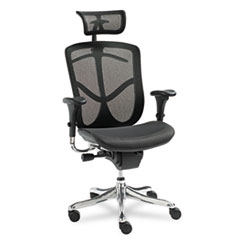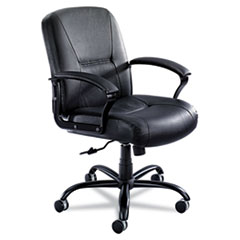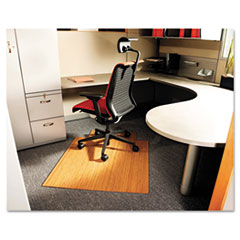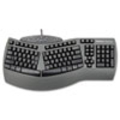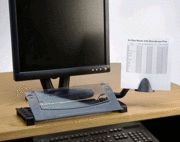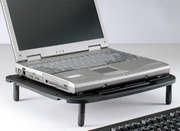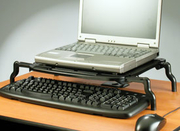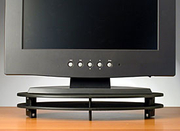What is an ergonomic office chair?
The ergonomic office chair is a term used by most of the over 300 chair manufacturers. However, a true ergonomic chair allows the individual using it to bring their work to them, rather than them adjusting to reach their work.
When adjusting your chair, you should be able to sit with your feet firmly planted on the ground. The space between the back of your knee and the edge of the chair should be equivalent to about three fingers. Next, your upper body and lower body should be in an open angle, not a right angle of 90 degrees. This allows blood flow to your lower extremeties. Also, your shoulders should be relaxed. They should not be in an upward "shrug" position. Finally, you should be able to lean back and recline while talking on the phone or meeting with others. This allows you to give your eyes and neck a break from the intense focus often associated with computer work.
There are other ergonomic features to consider. The popular mesh back chairs allow for air flow. This reduces the discomfort of being too hot or cold. Also, the mesh can reduce the pressure points that cause you to "fidget". Lumbar, or lower back, support is also a feature that helps create a healthier posture. This will increase your productivity and promote better comfort.
There are many manufacturers that call their chair ergonomic. Humanscale, Steelcase, Herman Miller and Haworth are just a few of the leading names. Allseating, BodyBilt Ergogenesis and Neutral Posture are additional brands that make ergonomic seating.
The most important thing to remember in finding a chair that is ergonomic is you! Each person is different. We work differently, we are different heights and weights and we have different physical concerns when selecting our chair. Also, budget is a concern for most of us. If your chair can adjust to allow you to work right, you have found the right ergonomic chair for your needs. You will likey increase productivity, reduce strain and feel better too.
Is there a Leather Office Chair for Big & Tall people?
There are options for folks who are above average weight and stature.
However, most people never think to ask how much weight their chair is tested to. The average chair is safe up to about 250 lbs of weight.
The danger is in a failure of the cylinder that raises and lowers the chair. Also, the arms are often used for getting up from a seated position and can break if too much pressure is put on them. Finally, if a mechanism fails, it can tip over and cause injury.
This leather chair allows for the strength and durability required in a true big and tall chair. Specially designed for the big and tall person -- supports up to 500 lbs. Luxurious leather upholstery for style and comfort. Supportive padded loop arms. Oversized five-star base with casters for stability and mobility.
Why You Need A Chairmat ...
Can a chairmat be considered an ergonomic accessory? Yes, it can. A chair mat extends the life of the carpet by protecting it from pulls, tears, wear and divots caused by wheel casters on a chair. It can also protect fine hard floors, tile and ceramic floors from marks and damage. However, from an ergonomic perspective, a floor mat provides smooth mobility, reducing the amount of stress on your back as you move around your work area. My personal favorite is the bamboo chairmat. This eco-chic design offers a nicer look than that old hard plastic mat that I remember from the 1980s. These are easy to roll up and stow away. They are sustainably harvested in the Anji Mountains. They have rounded edges to allow for easy on and off access. They work best on thin carpet or hardwood floors. A tough, durable solution that adds natural style to your office!
Indoff National Sales Meeting
As I wait to board my flight back to Connecticut from St Louis, I am excited to get back home and implement the exciting changes to this site. I met with manufacturer reps from Vu Ryte and RightAngle and found some great alternatives to the big expensive ergonomic products manufacturers. While Humanscale, ESI and WorkRite may dominate the market with brand names and marketing dollars, it comes down to one queation. Where can I find the best value to relieve my ergonomic issues? This site will begin to review, and discuss, such topics.
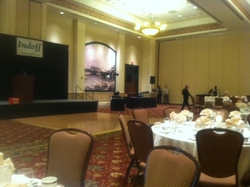
Environment and Health
When we think of an “environment” we usually think of some place far off and primeval, however this is too narrow a definition. The office or factory floor is also an environment, albeit a synthetic one. The natural environment can be a dangerous place, filled with hazards ranging from crumbling ledges and landslides to venomous snakes and stinging insects, and even such mundane objects as the piece of marsh grass that I once spent four hours in the ER having removed from my foot after a walk on the beach. We don’t control the natural environment, but we do control the workplace environment, and since we do control it it should not be filled with avoidable dangers.
We all know about dangers from falls and repetitive strain and awkward lifts and simple overloading, but those are relatively active hazards. There are others that are more passive and those are the ones that I think of as “environmental”, the sort of thing that is a danger simply because one is in its presence.
A few of these are noise, heat, cold, and airborne toxic substances.
Let’s look at noise. It’s estimated that more than 30 million Americans are exposed to dangerous levels of noise in the workplace. The trouble with noise is that the effects are cumulative and the effects are not always immediately apparent. Most offices are relatively quiet places where harmful levels of noise are rare. Warehouses and factory floors on the other hand are filled with noise sources. While some of these sources are obvious, others are less so. Some forklifts, for example, are noisy enough to cause hearing damage in less than half a shift of exposure. There’s a magic number, “85 dBA”, above that there’s danger of hearing damage. Checking is surprisingly easy—sound level meters are available for under $100—if the meter says the noise is over 85 dBA then there’s a problem. How big a problem and what to do about it may require expert advice. OSHA addresses noise in their Technical Manual Chapter III Section 5.
With most offices being air conditioned these days heat is more of an issue on the job site or factory floor than it is in the office. There is a temptation to expect employees to just gut it out when the temperature rises, however this is dangerous. In 1956 the US Marine Corps in response to an unacceptable number of heat related injuries came up with a set of guidelines for activities vs temperature and humidity. Those guidelines have been adjusted several times and are now used by all the armed forces, and in modified form by OSHA, as publishes in Section III Chapter 4 of the OSHA Technical Manual.
Cold is usually not an issue in offices or on factory floors. It can be an issue however on job sites and in food service and other industries where walk-in refrigeration is used. OSHA doesn’t have specific recommendations of which I am aware, however Air Force publication AFPAM 48-151 gives a good deal of useful information.
All sorts of airborne materials can get into the work environment. Remember Legionnaire’s Disease, which was first discovered in the air conditioning system of the Bellevue-Stratford Hotel after 34 deaths? Such incidents can be avoided by proper maintenance of environmental control systems. Other than the air conditioning system, toxic risks that can occur in an office include problems with the structure such as mold or asbestos. Also, spills can occur, ranging from toner from copy machines and laser printers to solvents used during cleaning or maintenance. Structure problems generally require specialized remediation and may involve closing the office for a period of time. Toner can be insidious--some of it is very finely divided and electrically conductive—vacuuming it up can result in an unpleasant surprise as it flows right through the vacuum cleaner bag and shorts out the motor. Spills generally have to be cleaned, what other action is required depends on the nature and quantity of the spill. If the substance is flammable special precautions may be needed to avoid igniting it during cleanup. The Material Safety Data Sheet should be consulted before the material is brought in to determine any hazards associated with it—after five gallons of something lethal are on the floor is too late to start reading. Toxic chemicals on the factory floor or job site have their own specialized rules and procedures—if uncertain as to the proper way to handle a particular substance a safety engineer should be consulted before it is put into service.
These are just a few of the health hazards that can occur in a business environment.
Safety Committee
While there is no Federal requirement as yet, many state occupational safety statutes require some or all businesses to form safety committees. To take a few examples, at this time Oregon requires all businesses with more than one employee to have a safety committee or to conduct safety meetings, Connecticut requires a safety committee for all businesses with 25 or more employees, California requires various safety-related reports to be filed and allows a safety committee to be used to submit those reports, and Georgia has no requirements related to safety committees at all.
Further, the composition and size of the safety committee may be mandated by law. Connecticut doesn’t specify how many members a safety committee must have but does require that half or more be non-managerial employees selected by the employees. Oregon on the other hand requires that the committee have at least 2 members for an organization with 20 or less employees or at least 4 for an organization with more than 20, with half being employer-selected and half being employee-selected.
The statutes may also specify how often the committee must meet, what records it must maintain, how long they are to be retained, and provide other detailed requirements concerning the activities of the committee.
The safety committee has many duties, some required by statute. One of the most essential is to record all workplace accidents, whether they are reportable or not, as this provides the base of information necessary to make informed decisions about actions required to improve safety and allows resources to be allocated most effectively. Another is to educate. This includes distributing and/or posting legally-mandated safety-related materials but also includes providing for safety-related training, and making employees aware of the committee and its purpose. It has a communications task—both in making employees aware of safety issues and in collecting and acting on reports of safety issues submitted by employees. The committee also has a responsibility to educate its own members, both regarding the law and regulations that affect the business and in the recognition and remediation of safety issues.
The Safety Committee must if it is to be effective avoid being seen as an adversary by either management or employees. To do that it needs to investigate incidents openly, fairly, and promptly, and submit recommendations to management that can be implemented with available or attainable resources. This can require a good deal of creativity on the part of the committee.
Management should see the Safety Committee as an opportunity to increase productivity and reduce costs by proactively addressing safety issues. Employees should see it as an advocate that acts to protect them from potentially hazardous working conditions.
Health In An Office
While ergonomics can’t do anything about flu season, it can help avoid lost time and increased expenses from a variety of work-related medical conditions.
So let’s look at a few.
The most common cause of lost-time injuries among office workers is simply falling down. There are many reasons office workers fall and the resulting injuries can be severe—broken bones, spinal injury, even death. Common causes include tripping over electrical cords, open drawers, or loose carpet, slipping on spilled liquids, falling while reaching from unstable chairs, and using chairs as stepstools or ladders. If the worker is carrying a heavy load the likelihood of injury is increased. Often the worker falls because his or her field of view is obstructed by an object being carried or because the worker is reading a document while walking.
How can ergonomics help with preventing falls? Most of the solutions are obvious—ergonomic solutions are often also common sense solutions. Electrical cords should not be left in traffic aisles—this doesn’t mean that the janitor should be harassed for not moving the vacuum cleaner plug every 30 seconds, but it does mean that those power strips that have been there so long that the cord has worn a hole in the carpet should be replaced either with code compliant outlets or with cords run outside of the traffic aisle. Spills should be cleaned up promptly, ideally by the first person to notice them. If there is material stored overhead, an appropriate number of step stools or ladders should be provided to allow it to be reached without climbing on chairs. Furniture should be arranged so that wherever possible drawers and doors do not open into traffic aisles. If heavy loads are carried regularly an appropriate quantity of carts or other carrying devices should be provided. Teach workers to check the path where they’re going to be carrying a heavy load to check for obstructions and to let those along the path know that a load is coming through. Also teach them not to read documents while walking. Inspect all carpets regularly and replace or repair any that present a tripping hazard. Note that a carpet that is fine for a person in flat shoes may be a hazard for someone in heels. Ideally there should be a contact person to whom tripping hazards should be reported, whose job description includes addressing such problems.
The most common type of injury in the office is the back injury. This can result from falls, improper lifting and carrying, awkward postures with heavy loads, and even from bending down. We don’t usually think of office workers as people who lift heavy loads, but a fully loaded legal-sized Bankers Box weighs more than 70 pounds, and a filled metal drawer from a filing cabinet can be even heavier. And this leaves aside office machines—some “desktop” laser printers and copiers can weigh a hundred pounds or more. In addition to the steps listed under falls, workers should be trained in proper lifting technique to avoid back injuries.
The next most common health issue in the office is cuts. Office workers regularly open boxes and packages and other such materials and usually use knives or scissors to do it, with the occasional cut resulting. While usually these are band-aid injuries, they can be serious—a box cutter is quite capable of inflicting a fatal injury. Paper itself also cuts—while such cuts tend to be minor they can become infected. Also there are cuts from other sources—broken glass, sharp metal edges, and the like. Workers should be issued appropriate cutting tools—there are box-openers with minimally exposed blades for example that work well and make it difficult for the worker to be injured. For those who need fully exposed blades, cut-proof gloves are available. There should be procedures for dealing with broken glass and other “sharps” including disposal of knife blades, and a contact person for remediation of exposed sharp edges on furniture and structure.
Between them, knee, shoulder, and ankle injuries are about as common as back injuries although none of them alone occurs as often as cuts. They generally result from improper lifting and from falls and are addressed in the same manner as back injuries, with proper training in lifting. Shoulder injuries can also result from repetitive actions involving the use of keyboard and mouse and can be addressed by proper arrangement of workstations, posture, and taking regular breaks to stretch and relax the shoulder muscles.
Wrist injuries are relatively uncommon, and again may be related to lifting or falls, but also among heavy keyboard users may result from repetitive actions. They can be addressed by proper workstation layout and posture, regular changes of task, and periodic breaks to stretch and to allow the muscles involved to relax.
These are only a few ways in which ergonomic considerations can address health in an office environment.
Ergonomic Hazards
The University of Chicago School of Environmental Health and Safety defines "Ergonomic Hazards" as "workplace conditions that pose the risk of injury to the musculoskeletal system of the worker." The Canadian Center for Occupational Health and Safety (their equivalent of OSHA) uses a similar definition. OSHA doesn't provide one of their own.
OSHA states "employers must keep their workplaces free from recognized serious hazards, including ergonomic hazards" and can cite employers which fail to do so. They state as a matter of policy that "The basic criteria OSHA will use in deciding whether to cite are those imposed by the General Duty Clause itself:
a.. whether there exists an ergonomic hazard,
b.. whether that hazard is recognized,
c.. whether the hazard is causing, or is likely to cause, serious physical harm to employees,
d.. and whether a feasible means exists to reduce the hazard."
Their expectation is that an employer will make a good faith effort to minimize ergonomic hazards at all sites under that employer's control.
But what, really is an "ergonomic hazard"? The University of Chicago says that they include "repetitive and forceful movements, vibration, temperature extremes, and awkward postures that arise from improper work methods and improperly designed workstations, tools, and equipment."
A real world example is instructive: The US Postal Service has been cited on several occasions for ergonomic hazards surrounding the use of the Delivery Bar Code Sorter machine. The following are from a letter to the Postmaster General from the Assistant Secretary for Occupational Safety and Health, dated January 2011.
"Bending and Twisting While Lifting Heavy Weight." Lifting mail trays to the lower levels of hampers and other transport devices requires twisting the torso while carrying heavy loads.
"Repeated Forceful Gripping, Finger Exertion and Contact Trauma." Removing rubber bands, cutting bands from trays, gripping stacks of mail with one hand, bent wrist postures, and use of tools with sharp or hard edges on the grip surfaces.
"Repeated Lifting of Heavy Weight." Some mail trays weigh as much as 70 pounds and nearly all exceed the Recommended Weight Limit generated from the NIOSH Revised Lifting Equation.
"Repeated, Extended Reaches."
"Repeated Forceful Shoulder Exertions" Excessive force was needed to hold stacks of mail together while lifting and moving it into and out of trays.
"Repeated Forceful Exertions with Awkward Postures" Heavy force with bent wrists is exerted "flipping " mail out of the machine's tray.
These are just a few examples, there were may others involving different parts of the machine. In many cases the problem could be corrected procedurally at little cost.
OSHA provides industry-specific guidelines for avoiding ergonomic hazards in many industries. In others it's up to the employer to identify and eliminate such hazards.
The History of Ergonomics
Ergonomics as a field of endeavor with a name dates back to 1857 when the word was created by Wojciech Jastrzebowski. However as a practical activity it is much much older. Very early toolmakers didn't really think about how tools fit the task, they chipped at their rock until it was comfortable fit and worked well, and if it never got there they found another rock. Later as work became more specialized toolmakers would produce more generic tools for many uses, however in the Middle Ages specialized tools such as armor were often fitted to the individual user because they simply didn't work properly otherwise.
But the subject was never approached in a systematic and scientific manner until Frederick W. Taylor, who in the 1880s began studying how much work a worker should reasonably be expected to produce and investigated systematic ways to increase their output. One of his most famous studies, conducted some years later, involved shovels, where he determined that the optimum load for a shovel was 21 pounds and increased productivity up to fourfold by simply sizing shovels for various materials so that they held 21 pounds of that material. Taylor called his approach "Scientific Management".
The next major contributer was Frank Gilbreth, who found a system to divide actions into a series of basic movements and analyze work activities in that manner. One of the results of this research was the use of a surgical nurse to provide instruments to the surgeon as called for, another is the system used by the military to teach recruits to disassemble and reassemle their weapoons in total darkness. In the 1920s he was invited to Japan to teach his methods, and while there layed the groundwork for the continuous process improvement methods that are now well known.
During WWII it was discovered that the design and arrangement of controls and instruments in aicraft cockpits had a significant effect on pilot performance and standardized layouts were developed.
After the war, the field broadened considerably, with a professional society, the International Ergonomics Association, forming in 1959. This is also the time when ergonomics took on its current meaning, subsuming several other disciplines such as "human factors".
It has since diversified into physical ergonomics, cognitive ergonomics, and organizational ergonomics. All are concerned with work and its relation to the worker, but in different ways.
Physical ergonomics is concerned with devices, objects, and the dimensions, movements, and capabilities of the human body, strength, flexibility, and the like.
Cognitive ergonomics deals with the mental aspects, memory, reasoning, reaction times, and such.
Organizational ergonomics deals with the optimation of the organization itself, its processes and policies.
Today ergonomics is ubiquitous, it appears in promotional materials, in the design of automobiles and airplanes and ships, even the shape of commonplace kitchen utensils.
How Do You Define Ergonomic Keyboard
Each manufacturer has their own definition, but generally speaking an "ergonomic keyboard" is a keyboard that a manufacturer has claimed is "ergonomic". They share some common features. Nearly all have the typing keys split into two or more sections, set at an angle. In some the center is raised, in others the two sections are physically separate, in yet others they are arranged as vertical columns and in others the two sections are on adjustable stands allowing them to be tilted and rotated. Some have alternative key layouts, or even unusual uses of keys (for example one where each key types one of four different characters after being moved laterally).
A consideration often neglected is the key movement, what's called "feedback". There are keys that send the character at the bottom of their stroke, and there are others that do so on the way down, giving a change in force that can be felt or an audible "click" sound or both to indicate that the character has been sent. The keyboards that provide that sort of feedback allow the typist to stop applying pressure before the sudden shock as the key hits the stop at the bottom of its travel. There is a viewpoint that this will help prevent repetitive strain injuries such as carpal tunnel syndrome, but again little research.
One surprising research result is that mouse use seems to have more effect on repetitive strain injuries than keyboard use. Since the design of the keyboard affects mouse placement to some extent (for a right handed person it's a longer reach to the mouse if there is a number pad than if there isn't for example) some consideration should be given to such placement for uses who switch between keyboard and mouse frequently, including possibly selecting keyboards that eliminate the number pad for users who do not normally make use of it.
The thing all ergonomic keyboards, however defined, have in common is that there is little independent research to support the claims that they confer benefit. For most the manufacturers have testimonials that claim increases in comfort, and for some there is independent research to support these claims. However the major selling point is that they in some manner address the risk of carpal tunnel syndrome and there is little evidence that alternative keyboard designs do in fact have such a benefit. Studies are mixed on whether keyboard use contributes significantly to carpal tunnel syndrome at all. There are indications that it is mostly likely with typists who keyboard more than 20 hrs/week at an average speed exceeding 25 words/minute with the risk increasing with both time and speed. But even there the resarch is patchy. My own view on this is that anybody who can sustain 25 or more words a minute for 4 hours at a stretch every day should probably have whatever keyboard they like within reason.
For users other than high volume data entry workers, ergonomic keyboards are unlikely to convey any significant benefit in terms of injury prevention, however they can have employee-morale benefits and this in turn can indirectly improve productivity. A caution though, while most workers will be delighted to have a new fancy keyboard, some become very attached to a specific layout and forcing change on them can bring about resentment, so such change should be voluntary.

